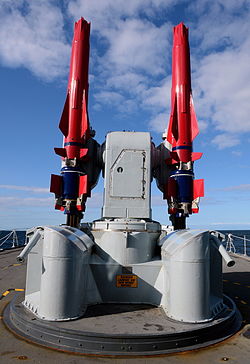Sea Dart (missile)
| Sea Dart | |
|---|---|

Sea Dart drill missiles on HMS Edinburgh in 2012
|
|
| Type | Surface-to-air, surface-to-surface |
| Place of origin | United Kingdom |
| Service history | |
| In service | 1973 – 2012 |
| Used by | See operators |
| Wars |
Falklands War Gulf 1991 |
| Production history | |
| Designer | Hawker Siddeley Dynamics |
| Designed | 1963 |
| Manufacturer | Hawker Siddeley Dynamics (1963–1977) BAe Dynamics (1977–1999) MBDA (UK) Ltd (since 1999) |
| Produced | 1970 |
| No. built | 2,000+ |
| Specifications | |
| Weight | 550 kg (1,210 lb) |
| Length | 4.4 m (14 ft) |
| Diameter | 0.42 m (17 in) |
| Warhead | 11 kg (24 lb) HE. Blast-fragmentation |
|
Detonation
mechanism |
Proximity fuze and contact |
|
|
|
| Engine |
Chow solid-fuel booster motor Bristol Siddeley Odin ramjet cruise motor |
| Wingspan | 0.9 m (3.0 ft) |
|
Operational
range |
Mod 0 (basic) 40 nmi (46 mi; 74 km) Mod 2 (upgrade) 80 nmi (92 mi; 150 km) |
| Flight ceiling | Greater than 10,000 m (33,000 ft) |
| Speed | Mach 2.0+ |
|
Guidance
system |
Semi-active radar illuminated by radar Type 909 |
|
Steering
system |
control surfaces |
|
Launch
platform |
ship |
Sea Dart or GWS30 was a British surface-to-air missile system designed by Hawker Siddeley Dynamics and built by British Aerospace from 1977. It was fitted to the Type 42 destroyers (UK and Argentina), Type 82 destroyer and Invincible-class aircraft carriers of the Royal Navy. The missile system has had nine confirmed successful engagements in combat, including six aeroplanes, two helicopters and a missile.
Sea Dart began as Hawker Siddeley project "CF.299", a weapon to replace the Royal Navy's first-generation long-range surface-to-air missile, Seaslug. It entered service in 1973 on the sole Type 82 destroyer HMS Bristol before widespread deployment on the Type 42 destroyer commencing with HMS Sheffield in 1976. The missile system was also fitted to Invincible-class aircraft carriers but was removed during refits in the 1998-2000 period to increase the area of the flight deck and below-decks stowage associated with the operation of Royal Air Force Harrier GR9 aircraft.
Sea Dart is a two-stage, 4.4-metre (14 ft) long missile weighing 550 kilograms (1,210 lb). It is launched using a drop-off Chow solid-fuel booster that accelerates it to the supersonic speed necessary for the operation of the cruise motor, a Rolls-Royce [Bristol Siddeley] kerosene-fuelled Odin ramjet. This gives a cruise speed of over Mach 2.5, and unlike many rocket-powered designs the cruise engine burns for the entire flight, giving excellent terminal manoeuvrability at extreme range. It is capable of engaging targets out to at least 30 nautical miles (35 mi; 56 km) over a wide range of altitudes. It has a secondary capability against small surface vessels, tested against a Brave-class fast patrol boat, although in surface mode the warhead safety arming unit does not arm and thus damage inflicted is restricted to the physical impact of the half-ton missile body and the unspent proportion of the 46 litres (10 imp gal; 12 US gal) of kerosene fuel.
...
Wikipedia
